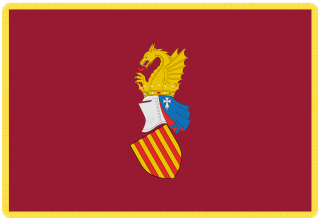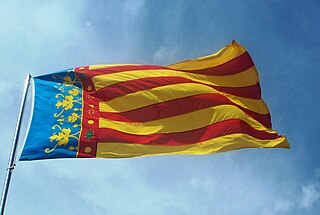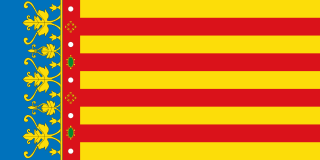Generalitat is the name of two major medieval and early modern political institutions and their modern-day analogues in Kingdom of Spain. The ancient Principality of Catalonia and the Kingdom of Valencia were ruled by Generalitats. Today, Catalonia and The Valencian Community have systems of self-government called Generalitats, and are two of 17 autonomous communities of Spain. The term is also used for the government of the semi-autonomous comarca of Val d'Aran, the Generalitat a l'Aran.

Valencian or the Valencian language is the official, historical and traditional name used in the Valencian Community of Spain to refer to the Romance language also known as Catalan, either as a whole or in its Valencia-specific linguistic forms. The Valencian Community's 1982 Statute of Autonomy officially recognises Valencian as the name of the regional language.

The Catalan Countries are those territories where the Catalan language is spoken. They include the Spanish regions of Catalonia, the Balearic Islands, Valencian Community, and parts of Aragon and Murcia (Carche), as well as the Principality of Andorra, the department of Pyrénées-Orientales in France, and the city of Alghero in Sardinia (Italy). It is often used as a sociolinguistic term to describe the cultural-linguistic area where Catalan is spoken. In the context of Catalan nationalism, the term is sometimes used in a more restricted way to refer to just Catalonia, Valencia and the Balearic Islands. The Catalan Countries do not correspond to any present or past political or administrative unit, though most of the area belonged to the Crown of Aragon in the Middle Ages. Parts of Valencia (Spanish) and Catalonia (Occitan) are not Catalan-speaking.

The Generalitat Valenciana is the generic name covering the different self-government institutions under which the Spanish autonomous community of Valencia is politically organized.

The Senyera is a vexillological symbol based on the coat of arms of the Crown of Aragon, which consists of four red stripes on a yellow field. This coat of arms, often called bars of Aragon, or simply "the four bars", historically represented the King of the Crown of Aragon.

The estrelada or valencian national flag is an unofficial flag typically flown by republican Valencian supporters to express their support for an independent Republic of Valencia. It evolved from the flag of the city of Valencia, called senyera coronada.
The names of the Valencian Community are diverse, even though Comunitat Valenciana is the only denomination with official status in its Statute of Autonomy. Nonetheless, this legal document includes in its Preamble other legal denominations that portray the history and nature of the territory: Regne de València and País Valencià.
Blaverism is a Valencian regionalist ideology in the Valencian Community (Spain) that emerged with the Spanish transition to democracy characterised by strong anti-Catalanism, born out of its opposition to Joan Fuster's book Nosaltres, els valencians (1962), which promoted the concept of the Catalan Countries which includes Valencia. They consider Fuster's ideas as an imperialist Catalan nationalist movement that tries to impose Catalan domination upon Valencia. Blaverism takes its name from the blue fringe which distinguishes the Valencian flag from other flags with a common origin, particularly from the Catalan.

The flag of the Valencian Community and of the city of Valencia, known as Reial Senyera, is the traditional Senyera, composed of four red bars on a yellow background, crowned with a blue strip party per pale next to the hoist. It was adopted on 1 July 1982.

The coat of arms of the Valencian Community is the official emblem of the self-government institutions of the Valencian Community. It is based on the armorial achievement used from the reign of King Peter IV to John II, called the Great. In 1978 the former Council of the Valencian Country approved it “...for being the oldest known representative emblem of the former Kingdom of Valencia, that had located on the Xerea Gate of the city of Valencia”.

Valencian Left was a nationalist Valencian leftist political party founded in July 1934, that advocated self-determination of the Valencian Community. The party was suppressed in Francoist Spain and was not revived when democracy returned to Spain in the late 1970s.
Valencian nationalism or Valencianism is a political movement in the Valencian Community, Spain.

The Himne de l'Exposició or Himne de València is the official anthem of the Valencian Community, Spain. The song was composed by José Serrano Simeón with lyrics written by Maximiliano Thous Orts for the Valencia Regional Exhibition. The music is based on a 16th-century anthem dedicated to Saint George, who was the patron saint of the Kingdom of Valencia. It was approved by the mayors of Alicante, Castellón and Valencia in May 1925, and it was declared as the official anthem of the Valencian Community in 1981, with the approval of the Valencian Statute of Autonomy.

The Valencian Community is an autonomous community of Spain. It is the fourth most populous Spanish autonomous community after Andalusia, Catalonia and the Community of Madrid with more than five million inhabitants. Its homonymous capital Valencia is the third largest city and metropolitan area in Spain. It is located along the Mediterranean coast on the east side of the Iberian Peninsula. It borders Catalonia to the north, Aragon and Castilla–La Mancha to the west, and Murcia to the south, and the Balearic Islands are to its east. The Valencian Community is divided into three provinces: Castellón, Valencia and Alicante.

Vicente Ruiz Monrabal was a Spanish lawyer and politician.

The president of the Valencian Government is the head of the Generalitat Valenciana, the government of the Spanish autonomous community of Valencia. The president is chosen by the Valencian parliament, the Corts Valencianes.
Enric Monsonís Domingo was a Spanish liberal politician. Monsonís served as the head of the pre-autonomous government of the Consell Pre-autonòmic del País Valencià from 1979 to 1982. He left office in 1982 when Valencia became an autonomous community of Spain, known as the Valencian Community, and elected its first democratically chosen President of the Valencian Government, Joan Lerma as part of the country's transition to democracy.
Valencian regionalism is a cultural and political movement that advocates the revival of the identity of the region now within the Valencian Community in eastern Spain. Politically, the regionalists support the administrative decentralisation of the Spanish state and, for some, the recognition of Valencian foral law and increased autonomy for the Valencian Community. The movement emerged during the early years of the Bourbon restoration in the last third of the 19th century. It took political shape during the early 20th century, and persisted in a controlled and attenuated form through the Francoist State. After the restoration of democracy, the regionalist tendency was challenged by a Valencian nationalism with some left-wing and pan-Catalanist associations. Regionalism took on a right-wing and anti-Catalanist outlook which became known as Blaverism, and was represented politically by the Valencian Union until the absorption of that party into the People's Party in 2011.

Democratic Union of the Valencian Country was a political party in the Valencian Country, Spain. It was founded clandestinely in the University of Valencia in 1962. The party was illegal until 1977.
Valencian Regional Union was a Valencianist and anti-Catalanist political party founded in the Valencian Community in 1977.













